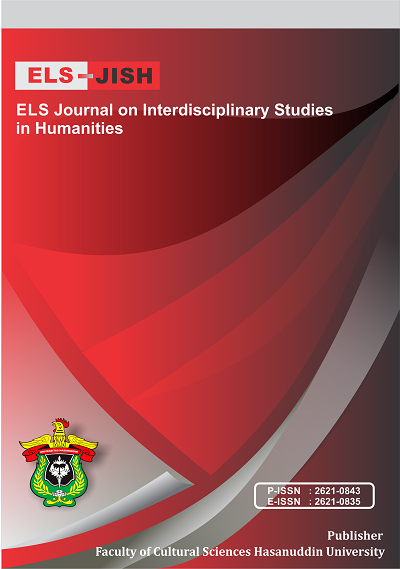A Stylistic Study of Situational Elements in Selected American Creeds
DOI:
https://doi.org/10.34050/elsjish.v6i1.24990Keywords:
Military Creeds, Situational Elements, StylisticsAbstract
The study is intended to stylistically analyze a sample of three American military creeds. The study hypothesizes that American military creeds have their own stylistic properties which make them distinct texts, and that the stylistic devices employed in military creeds vary in terms of their frequencies and functions. The study also hypothesizes that military creeds are situationally based, and that the employed stylistic devices have a complementary role. They all contribute together to fulfill the creeds’ aims and convey their intended messages. To achieve the aims of the study, and verify its hypotheses, two types of procedure are followed: theoretical and practical. The theoretical part consists of presenting a theoretical framework of style and stylistics including their historical background, types, approaches, models of analysis, etc. Another theoretical framework is also presented about military discourse and creeds including their historical background, terminology, features, etc. On the other hand, the practical part consists of selecting a sample of three military creeds and analyzing them in the light of Crystal and Davy’s (1969) model which accounts for situational elements. The adopted model consists of five dimensions: individuality, discourse, status, modality, and singularity. The results of analysis show that military creeds have their own distinctive stylistic features. The results also show that the stylistic devices characterizing military creeds have a complementary role in that they all contribute together to achieve the creeds’ aims and convey their intended messages.
References
Andini, C. (2017). Children Emotion in The Movie" Big Hero 6" (Doctoral dissertation, Universitas Islam Negeri Alauddin Makassar).
Barry, P. (2020). Beginning theory: An introduction to literary and cultural theory. In Beginning theory (fourth edition). Manchester university press.
Bradford, R. (1997). Stylistics. London and New York: Routledge.
Carter, R., & Simpson, P. (1989). Language, discourse and literature: A reader in discourse stylistics. London and New York: Routledge.
Charteris-Black, J. (2014). Analysing Political Speeches: Rhetoric, Discourse and Metaphor. Hampshire, UK: Palgrave MacMillan.
Coupland, N. (2007). Style: Language variation and identity. Cambridge University Press.
Crystal, D. & Davy, D. (1969). Investigating English Style. London: Longman Group UK Ltd.
Dzhonovich, M. P. (2014). English military slang: definition, means of formation and thematic classification. Language and Culture, (3), 53-60.
El Baff, R., Wachsmuth, H., Al Khatib, K., & Stein, B. (2020). Analyzing the persuasive effect of style in news editorial argumentation. Proceedings of the 58th Annual Meeting of the Association for Computational Linguistics, pages 3154–3160 July 5 - 10, 2020. c 2020 Association for Computational Linguistics
Enkvist, N. E. (2016). Linguistic stylistics. In Linguistic stylistics. De Gruyter Mouton.
Gibbons, A. & Whiteley S. (2018). Contemporary Stylistics: Language. Cognition, Interpretation.
Halmari, H. & Virtanen, T. (2005). Persuasion across genres: A linguistic approach. John Benjamins Publishing.
Hejal, A. J. J. (2006). “Stylistics: a contact between linguistics and literary criticism”. Journal of the College of Basic Education Al Mustansinyah University, (48), 1-10.
Hough, G. (1969). Style and stylistics. London: Routledge and Kegan Paul.
Howard, D. (1956). United States Marine Corps Slang. American Speech, 31(3), pp 188–194. https://doi.org/10.2307/453678
Jeffries, L. & McIntyre, D. (2010). Stylistics. Cambridge University Press.
Lintao, R. B. (2013). Traversing the Speech and Thought Presentation Features of Merlinda Bobis‟s „The Sadness Collector. Asian Journal of English Language Studies (AJELS), 1.
Missikova G. (2003). Linguistic Stylistics. New York: Columbia University Press.
Nnadi, I. C. (2010). A Linguistic Stylistic Analysis Of Chukwuemeka Ike's Novels (Doctoral dissertation).
Nordhielm, C. L. (2003). A Levels-of-Processing Model of Advertising Repetition Effects. In Persuasive Imagery (pp. 106-119). Routledge.
Odiljonovich, R. M., & Kurganov, A. M. (2021). Structural semantic and stylistic features of military terms in Uzbek and English languages. Eurasian Journal of Learning and Academic Teaching, 3, 23-25.
Rahman, F. (2018). The Constraints of Foreign Learners in Reading English Literary Works: A Case Study at Hasanuddin University. Journal of Arts and Humanities, 7(2), 01-12.
Rahman, F., Abbas, H., Akhmar, A. M., & Tahir, M. D. (2023). The Men and the Sea: Cultural Preservation of Bajau People with their Traditional Practice in Bone Regency. Journal of Positive Psychology and Wellbeing, 820-835.
Short, M. (1996). Exploring The Language of Poems, Plays and Prose. London: Longman.
Simpson P..(2004). Stylistics: A resource book for students. Psychology Press.
Stockwell, P. & Whiteley, S. (2014). The Cambridge handbook of stylistics. Cambridge University Press.
Sukmawaty, Rahman, F.F. & Andini, C. (2022). Covid-19 Pandemic and Axiology of Communication: A Study of Linguistic Phenomena. IJISRT, 7(4) 1079-1087.
Thornborrow, J. & Wareing, S. (1998). Patterns in language: An introduction to language and literary style. Psychology Press.
Varshney, R.L. (1980). An introductory text book of linguistics and phonetics. India: Students Store.
Verdonk, P. (2002). Stylistics. Oxford University Press.
Widowson, H.G. (1975) Stylistics and the Teaching of Literature. New York: Taylor & Francis.
Young, A. M. (2011). Quaffable, but uh... far from transcendent: Wine, rhetorical style, and politics. The Politics of Style and the Style of Politics. Ed. BarryBrummett. Lanham, MD: Lexington, 263-278.
Electronic Sources
https://military-history.fandom.com/wiki/Airman%27s_Creed
Downloads
Published
Issue
Section
License
Copyright (c) 2023 Ayad Hameed Mahmoud, Alyaa Husein Abd Fatah

This work is licensed under a Creative Commons Attribution-ShareAlike 4.0 International License.






